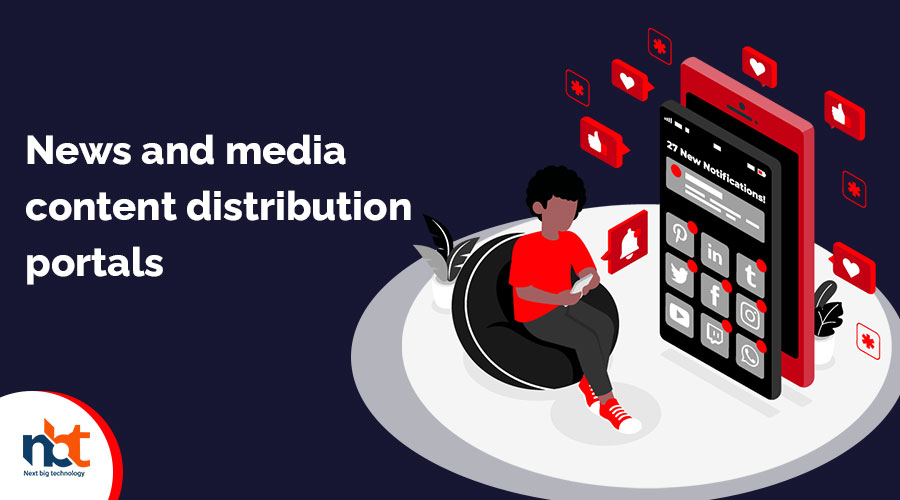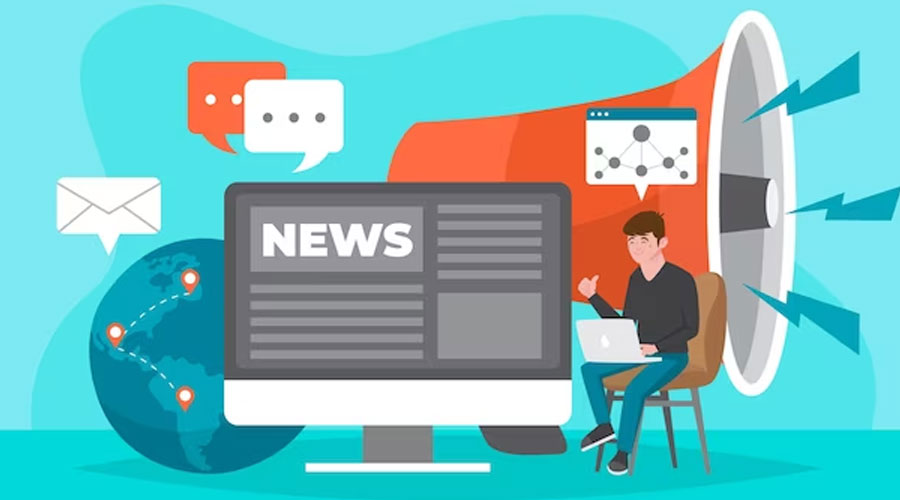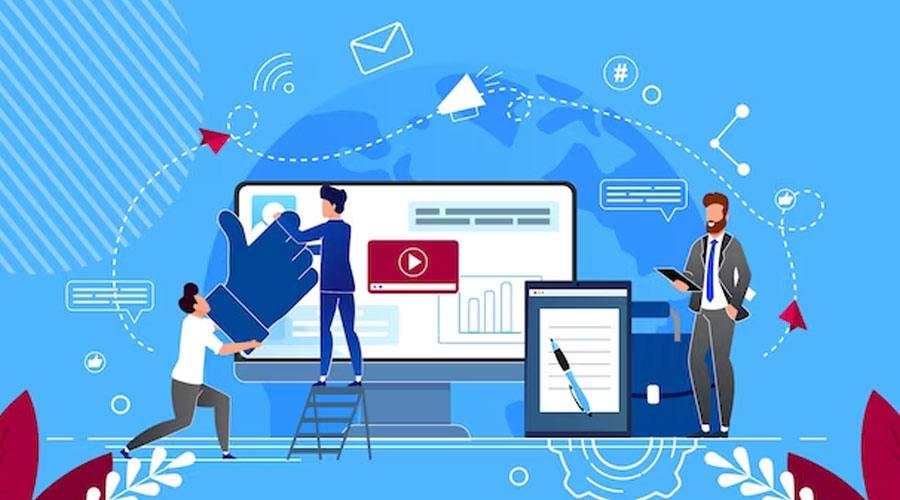Table of Contents
News and media content distribution portals Services
In today’s digital age, the landscape of news and media consumption is constantly evolving. With the advent of the internet and social media, the way we access information has undergone a dramatic transformation. Amidst this evolution, news and media content distribution portals have emerged as key players in disseminating information to a global audience.
These portals serve as centralized platforms where news organizations, content creators, and publishers can distribute their content to a wide audience efficiently and effectively. By leveraging technology and digital platforms, these services streamline the process of content distribution, making it easier for consumers to access the latest news and media content from various sources.
One of the significant advantages of news and media content distribution portals is their ability to reach a vast and diverse audience. Whether it’s breaking news, feature articles, or multimedia content, these portals provide a one-stop destination for consumers to stay informed about current events and topics of interest. This accessibility fosters greater transparency and democratization of information, empowering individuals with knowledge and awareness.
Furthermore, these portals play a crucial role in supporting independent journalism and content creators. By providing a platform for both established media outlets and emerging voices, they contribute to a vibrant and diverse media ecosystem. This diversity of perspectives enriches public discourse and fosters a more informed and engaged society.
From a business perspective, news and media content distribution portals offer valuable opportunities for monetization and revenue generation. Through advertising, subscriptions, and partnerships, these portals can sustainably support the creation and distribution of high-quality content. Additionally, they enable targeted content delivery, allowing advertisers to reach specific audiences with precision and effectiveness.
In recent years, the rise of digital streaming services and on-demand content platforms has further fueled the growth of news and media content distribution portals. These platforms offer users personalized content recommendations and curated news feeds, enhancing the user experience and driving engagement. With the proliferation of mobile devices and connected technologies, consumers now have unprecedented access to news and media content anytime, anywhere.
However, the proliferation of misinformation and fake news presents a significant challenge for news and media content distribution portals. In an era of information overload, distinguishing between credible sources and unreliable sources can be daunting for consumers. As such, these portals must prioritize accuracy, transparency, and editorial integrity to maintain trust and credibility with their audience.
How to Create a News and media content distribution portals
In today’s fast-paced digital world, the demand for reliable news and media content distribution portals is higher than ever. With countless sources available online, creating a platform that effectively delivers news content to audiences can be both challenging and rewarding. Whether you’re an aspiring entrepreneur or a media professional looking to expand your reach, establishing a successful news and media content distribution portal requires careful planning and execution.
Here’s a step-by-step guide to help you create your own news and media content distribution portal:
- Define Your Niche: Before diving into the creation process, it’s crucial to identify your target audience and the niche you want to serve. Consider the topics and themes your portal will cover, such as politics, entertainment, technology, or lifestyle. Defining your niche will help you tailor your content and attract a specific audience interested in those subjects.
- Choose a Platform: Selecting the right platform is essential for building your news and media distribution portal. You can opt for content management systems (CMS) like WordPress, Joomla, or Drupal, which offer customizable templates and plugins to streamline the development process. Alternatively, you can hire web developers to create a custom-built solution tailored to your specific requirements.
- Content Aggregation and Curation: To populate your portal with engaging content, you’ll need to aggregate news articles, videos, and multimedia from reputable sources. Utilize RSS feeds, APIs, and content syndication networks to gather content relevant to your niche. Additionally, consider implementing algorithms or manual curation to ensure the quality and relevance of the content displayed on your portal.
- Design and User Experience: The design and user experience of your portal play a significant role in attracting and retaining visitors. Choose a clean and intuitive layout that makes it easy for users to navigate and discover content. Incorporate features such as categories, search functionality, and personalized recommendations to enhance user engagement and satisfaction.
- Monetization Strategies: To sustain your news and media content distribution portal, explore various monetization strategies such as advertising, sponsored content, subscriptions, and affiliate marketing. Analyze your target audience and industry trends to determine the most effective revenue streams for your portal. Additionally, prioritize user experience to ensure that monetization efforts do not compromise the quality of your content or alienate your audience.
- SEO Optimization: Enhance the visibility of your portal in search engine results by implementing SEO best practices. Conduct keyword research to identify relevant search terms and incorporate them strategically into your content, metadata, and URLs. Optimize site speed, mobile responsiveness, and internal linking structure to improve user experience and search engine rankings.
- Promotion and Marketing: Once your portal is live, focus on promoting and marketing your content to attract a wider audience. Utilize social media platforms, email newsletters, influencer partnerships, and search engine marketing to increase visibility and drive traffic to your portal. Engage with your audience through interactive features such as comments, polls, and forums to foster community engagement and loyalty.
- Continuous Improvement: Monitor the performance of your news and media content distribution portal through analytics tools to track key metrics such as traffic, engagement, and revenue. Collect feedback from users and adapt your content strategy and features accordingly to meet evolving needs and preferences. Stay updated on industry trends and technological advancements to ensure that your portal remains competitive and relevant in the ever-changing media landscape.
Why Should You Go for News and media content distribution portals
In today’s digital age, information is everywhere, constantly bombarding us from all angles. With the rise of the internet, staying updated with the latest news and media content has never been easier. However, amidst this vast sea of information, navigating through it efficiently can be quite challenging. This is where news and media content distribution portals come into play, offering a plethora of benefits that make them a must-have tool for individuals and businesses alike.
- Centralized Source of Information: News and media content distribution portals serve as centralized hubs where you can access a wide array of news articles, videos, podcasts, and other forms of media content from various sources. Instead of hopping from one website to another, these portals provide a convenient one-stop destination for all your information needs.
- Diverse Content Selection: Whether you’re interested in global news, finance, technology, entertainment, or sports, these portals offer a diverse range of content catering to different interests and preferences. This ensures that you’re always in the loop, no matter what topic piques your curiosity.
- Timeliness and Relevance: With real-time updates and constant monitoring of news sources, content distribution portals deliver timely and relevant information round the clock. Whether it’s breaking news or in-depth analysis, you can trust these portals to keep you informed and up-to-date with the latest developments.
- Customization and Personalization: Many news and media distribution portals offer customization features that allow users to tailor their content preferences according to their interests and preferences. Whether you prefer specific news sources, topics, or formats, you can customize your feed to ensure that you receive content that aligns with your preferences.
- Accessibility and Convenience: Accessing news and media content through distribution portals is incredibly convenient, as you can do so from any internet-enabled device, whether it’s your smartphone, tablet, or computer. This level of accessibility ensures that you’re never far away from the latest updates and insights.
- Opportunities for Businesses: For businesses, leveraging news and media content distribution portals can be a powerful marketing and branding tool. By distributing press releases, articles, and other promotional content through these portals, businesses can amplify their reach, increase visibility, and engage with their target audience more effectively.
- SEO Benefits: From an SEO perspective, appearing on reputable news and media distribution portals can significantly boost a business’s online visibility and search engine rankings. By associating with authoritative sources and earning backlinks from high-quality content, businesses can enhance their digital presence and attract more organic traffic.
Market Prospects of Custom News and media content distribution portals and Platforms
In today’s digital age, where information is abundant and attention spans are fleeting, the demand for personalized news and media content distribution portals and platforms is skyrocketing. These platforms offer a tailored experience to users, catering to their specific interests and preferences, thus revolutionizing the way people consume information. As the digital landscape continues to evolve, the market prospects for such platforms are exceptionally promising.
- Rising Demand for Personalized Content: With an overwhelming amount of content available online, users are increasingly seeking personalized experiences that align with their interests and beliefs. Custom news and media content distribution portals and platforms leverage advanced algorithms and user data to curate content tailored to individual preferences, thereby enhancing user engagement and satisfaction.
- Catering to Diverse Audiences: One of the key advantages of custom news and media platforms is their ability to cater to diverse audiences. Whether it’s news, entertainment, lifestyle, or niche interests, these platforms offer a wide array of content categories to satisfy the preferences of different user segments. This versatility attracts a broad audience base, making these platforms highly appealing to advertisers and content creators alike.
- Monetization Opportunities: Custom news and media content distribution portals and platforms present lucrative monetization opportunities for businesses. Through targeted advertising, sponsored content, subscription models, and partnerships, these platforms can generate substantial revenue streams while providing value to both users and advertisers. Additionally, the ability to collect and analyze user data enables more precise targeting, maximizing the effectiveness of advertising campaigns.
- Emergence of New Technologies: Advancements in technology, such as artificial intelligence and machine learning, are driving innovation in the custom news and media content distribution space. These technologies empower platforms to deliver highly personalized experiences by analyzing user behavior, preferences, and engagement patterns in real-time. By harnessing the power of data-driven insights, platforms can continuously refine their algorithms to deliver increasingly relevant content to users.
- Competitive Landscape and Market Growth: The market for custom news and media content distribution portals and platforms is dynamic and competitive, with both established players and startups vying for market share. However, as the demand for personalized content continues to grow, there is ample room for expansion and innovation in this space. Market projections indicate robust growth in the coming years, driven by factors such as increasing internet penetration, smartphone adoption, and evolving consumer preferences.
- Challenges and Opportunities: While the market prospects for custom news and media content distribution platforms are promising, they also face certain challenges. These include concerns regarding data privacy, content quality, and maintaining user trust. However, by prioritizing transparency, data security, and user satisfaction, platforms can overcome these challenges and capitalize on the vast opportunities presented by the evolving digital landscape.
News and media content distribution portals Process
In today’s digital age, where information is constantly flowing and evolving, news and media content distribution portals play a pivotal role in disseminating news to the masses. These platforms serve as the gateways through which news organizations deliver their content to audiences worldwide. Understanding the process behind these portals is essential for both content creators and consumers alike.
Understanding the Infrastructure: News and media content distribution portals operate on sophisticated infrastructure designed to handle vast amounts of data efficiently. They utilize content management systems (CMS) that enable publishers to upload, organize, and distribute their content seamlessly. These systems often incorporate algorithms that prioritize content based on relevance, engagement, and audience demographics.
Content Submission and Moderation: For content creators, the process typically begins with submission to the distribution portal. This can involve uploading articles, videos, images, or other multimedia content. Once submitted, the content goes through a moderation process where it is reviewed for accuracy, relevance, and compliance with the portal’s guidelines and standards. This step ensures that only high-quality and trustworthy content is made available to the audience.
Curation and Personalization: Once approved, the content enters the curation phase, where it is categorized, tagged, and organized for optimal visibility. Many distribution portals employ personalized algorithms that analyze user behavior and preferences to deliver tailored content recommendations. This personalized approach enhances user engagement and retention by presenting them with content that aligns with their interests.
Distribution Channels: News and media content distribution portals utilize various channels to reach their audience effectively. These can include websites, mobile apps, social media platforms, newsletters, and syndication partnerships with other media outlets. By leveraging multiple channels, these portals maximize the reach and impact of their content, ensuring that it reaches audiences across different demographics and regions.
Analyzing Performance: Tracking and analyzing the performance of distributed content is crucial for optimizing future strategies. Distribution portals utilize analytics tools to monitor metrics such as page views, engagement rates, click-through rates, and social shares. This data provides valuable insights into audience behavior, content performance, and emerging trends, allowing publishers to refine their content strategies accordingly.
Adapting to Technological Advancements: The landscape of news and media content distribution is continually evolving, driven by advancements in technology and shifts in consumer behavior. Distribution portals must adapt to these changes by embracing emerging technologies such as artificial intelligence, machine learning, and blockchain to enhance content delivery, combat misinformation, and ensure data security.
Ensuring Ethical and Responsible Practices: With the rise of fake news and misinformation, ensuring ethical and responsible content distribution practices is more critical than ever. Distribution portals have a responsibility to uphold journalistic integrity, fact-checking standards, and transparency in their operations. This includes implementing measures to verify the authenticity of content, combat misinformation, and provide clear attribution to sources.
Next Big Technology – Your Trusted News and media content distribution portals Partner
In the dynamic world of news and media, staying ahead of the curve is crucial. With the rapid evolution of technology, media distribution channels are continuously transforming, presenting both challenges and opportunities for content creators and distributors alike. In this landscape, finding a trusted partner equipped with the latest technology to distribute your content effectively becomes paramount. Enter the next big technology – your ultimate news and media content distribution partner.
In an era where information travels at the speed of light, having a reliable platform to disseminate your content to the right audience is essential. Whether you’re a news agency, a content creator, or a media conglomerate, partnering with a cutting-edge technology solution can revolutionize your distribution strategy.
So, what exactly does the next big technology offer as your content distribution partner?
- Advanced Analytics: Understanding your audience is key to crafting compelling content. The next big technology provides advanced analytics tools that offer insights into audience behavior, preferences, and engagement patterns. By harnessing this data, you can tailor your content to better resonate with your target demographic, thus maximizing its impact.
- Personalized Content Delivery: With the proliferation of digital content, consumers expect personalized experiences. The next big technology leverages artificial intelligence and machine learning algorithms to deliver content tailored to each user’s interests and preferences. This personalized approach not only enhances user satisfaction but also increases engagement and retention rates.
- Multi-Channel Distribution: In today’s multi-platform environment, reaching audiences across various channels is imperative. Whether it’s through websites, mobile apps, social media, or emerging platforms like OTT (Over-the-Top) streaming services, the next big technology offers seamless multi-channel distribution capabilities, ensuring your content reaches audiences wherever they are.
- Monetization Opportunities: Content creators and distributors need sustainable revenue streams to thrive in the digital age. The next big technology provides robust monetization solutions, including advertising integrations, subscription models, pay-per-view options, and sponsorship opportunities. By monetizing your content effectively, you can maximize your profitability while delivering value to your audience.
- Scalability and Reliability: As your audience grows, so do your infrastructure needs. The next big technology offers scalable and reliable solutions that can accommodate increased traffic and demand without compromising performance or user experience. Whether you’re catering to thousands or millions of users, you can trust that your content will be delivered seamlessly and efficiently.
Enterprise News and media content distribution portals
In today’s fast-paced digital landscape, the dissemination of news and media content plays a pivotal role in shaping public opinion, driving engagement, and fostering connections between businesses and their target audience. Enterprise news and media content distribution portals stand at the forefront of this ecosystem, serving as the gateway through which valuable information reaches diverse audiences across the globe.
These portals serve as centralized platforms where businesses, organizations, and content creators can distribute their news releases, articles, videos, and other multimedia content to a wide range of audiences. By leveraging these portals, enterprises can amplify their reach, enhance brand visibility, and establish thought leadership within their respective industries.
One of the primary advantages of enterprise news and media content distribution portals is their ability to target specific audiences with tailored content. Through sophisticated targeting algorithms and user segmentation techniques, these portals ensure that content reaches the right people at the right time, maximizing its impact and relevance. Whether it’s industry-specific news for professionals or engaging multimedia content for general audiences, these portals offer a diverse array of distribution options to suit every need.
Furthermore, enterprise news and media content distribution portals provide valuable analytics and insights that enable businesses to track the performance of their content in real-time. From audience engagement metrics to social sharing statistics, these insights empower enterprises to refine their content strategies, optimize their messaging, and make data-driven decisions to drive greater ROI.
In addition to serving as distribution channels, these portals often function as hubs for industry news, trends, and insights, providing audiences with a one-stop destination for staying informed and up-to-date. By curating and aggregating content from a variety of sources, these portals become indispensable resources for professionals seeking to stay ahead in their respective fields.
Moreover, enterprise news and media content distribution portals play a crucial role in enhancing brand credibility and trust. By associating their content with reputable platforms, businesses can leverage the credibility and authority of these portals to enhance their own brand image and establish themselves as trustworthy sources of information.
Top News and media content distribution portals Companies
In today’s fast-paced digital age, staying informed is paramount, and news and media content distribution portals play a pivotal role in delivering timely and relevant information to audiences worldwide. From breaking news to in-depth analysis, these platforms serve as a gateway to a wealth of knowledge. Let’s delve into some of the top companies leading the charge in this dynamic industry.
-
-
Next Big Technology:
Next Big Technology is one of the top development companies for the high-quality development of mobile apps and web development services. They have having experienced in-house team of developers who provide top-notch development services according to the business requirements. NBT provides highly business-oriented services and implements all the latest and trending tools and technologies. They always work hard to deliver a top-notch solution at an affordable cost. They are having experience of more than 13 years and delivered lots of projects around the globe to businesses and clients.
NBT is highly focused on providing top-notch development solutions at a very affordable cost. By using their market experience and development experience, they are delivering proper solutions to clients and various industries for their custom requirements.
Location: India, USA, UK, Australia
Hourly Rate :< $25 per Hour
Employees: 50 – 249
Focus Area
- Mobile App Development
- App Designing (UI/UX)
- Software Development
- Web Development
- AR & VR Development
- Big Data & BI
- Cloud Computing Services
- DevOps
- E-commerce Development
Industries Focus
- Art, Entertainment & Music
- Business Services
- Consumer Products
- Designing
- Education
- Financial & Payments
- Gaming
- Government
- Healthcare & Medical
- Hospitality
- Information Technology
- Legal & Compliance
- Manufacturing
- Media
-
- Facebook: While primarily known as a social networking site, Facebook has emerged as a formidable player in the realm of news distribution. Through features like Instant Articles and News Feed, it enables publishers to reach a vast audience swiftly. With its emphasis on user engagement and sharing, Facebook has become an integral part of the modern news ecosystem.
- Twitter: Renowned for its real-time nature, Twitter serves as a hub for breaking news and trending topics. Its succinct format encourages brevity and immediacy, making it an ideal platform for journalists and media outlets to disseminate information rapidly. Through hashtags and retweets, content can quickly gain traction and reach a global audience.
- YouTube: As the largest video-sharing platform, YouTube offers a diverse array of news and media content. From live streams of press conferences to investigative documentaries, it caters to various preferences and interests. Its monetization options also incentivize creators to produce high-quality journalism and analysis.
- LinkedIn: Targeting a professional audience, LinkedIn has carved a niche for itself in the realm of business and industry news. Its News Feed and Pulse feature curate articles and insights relevant to users’ occupations and interests. With its focus on networking and professional development, LinkedIn serves as a valuable resource for staying abreast of industry trends and developments.
- Reddit: Dubbed as the “front page of the internet,” Reddit boasts an extensive array of communities (subreddits) dedicated to news and current events. Users can engage in discussions, share articles, and participate in AMA (Ask Me Anything) sessions with notable figures. Its democratic voting system ensures that noteworthy content rises to the top, offering a diverse range of perspectives.
- Apple News: Catering to users of Apple devices, Apple News provides a seamless experience for accessing news content across iPhone, iPad, and Mac. Its curated news feeds deliver articles from a wide range of publishers, blending algorithmic curation with human editors’ selections. With its user-friendly interface and integration with Apple’s ecosystem, it has garnered a loyal user base.
FAQs on News and media content distribution portals
In the ever-evolving landscape of news and media consumption, content distribution portals play a pivotal role in delivering information to audiences worldwide. These platforms serve as intermediaries between content creators and consumers, facilitating the dissemination of news articles, videos, podcasts, and more. However, navigating the intricacies of these portals can often raise questions. Let’s delve into some frequently asked questions (FAQs) regarding news and media content distribution portals:
- What are news and media content distribution portals? News and media content distribution portals are online platforms that aggregate, curate, and distribute news and multimedia content from various sources. They serve as centralized hubs where users can access a wide range of information across different topics and formats.
- How do these portals acquire content? Content distribution portals acquire content through partnerships with news organizations, media outlets, independent journalists, content creators, and sometimes through user-generated submissions. They employ algorithms and editorial teams to curate and organize content for optimal user experience.
- What types of content are available on these portals? These portals offer diverse content formats, including articles, videos, podcasts, infographics, and live streams, covering topics ranging from current events and politics to entertainment and lifestyle. Users can explore a plethora of content tailored to their interests and preferences.
- Are these portals free to use? Many news and media content distribution portals offer free access to their content, supported by advertising revenue. However, some may require a subscription or premium membership for access to exclusive features or ad-free browsing.
- How do these portals ensure content accuracy and reliability? Content distribution portals employ various mechanisms to verify the credibility of sources and maintain editorial standards. This includes fact-checking processes, editorial oversight, and adherence to journalistic ethics and guidelines. Additionally, user feedback and reporting mechanisms help identify and address misinformation.
- Can users contribute content to these portals? Some content distribution portals allow users to submit their content for consideration, particularly in the case of citizen journalism or community-driven platforms. However, content moderation policies and guidelines are in place to ensure quality, relevance, and compliance with terms of service.
- Do these portals prioritize certain types of content or sources? While content distribution portals strive to offer diverse perspectives and sources, they may employ algorithms or editorial discretion to prioritize content based on factors such as relevance, timeliness, and user engagement. Transparency in content curation practices is essential to maintain trust among users.
- How do these portals handle issues like copyright infringement or content misuse? Content distribution portals have policies and procedures in place to address copyright concerns and instances of content misuse. This may involve content takedowns, legal actions, or collaboration with rights holders to resolve disputes and uphold intellectual property rights.
- Are there any privacy concerns associated with using these portals? Like any online platform, news and media content distribution portals must prioritize user privacy and data protection. They should adhere to relevant privacy regulations and provide transparent information about data collection practices, usage policies, and security measures to safeguard user information.
- How can users provide feedback or report issues on these portals? Most content distribution portals offer channels for user feedback, including contact forms, customer support services, and community forums. Additionally, they may have reporting tools for flagging inappropriate content, technical glitches, or policy violations.
Thanks for reading our post “News and media content distribution portals”. Please connect with us to learn more about the News and media content distribution.
























